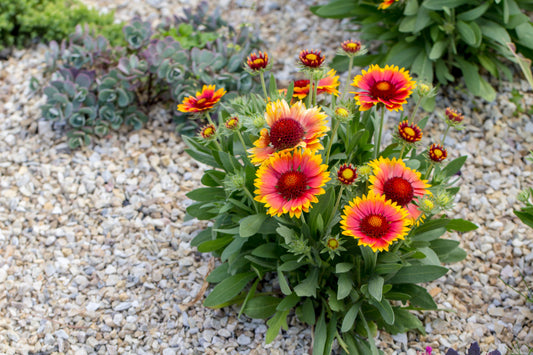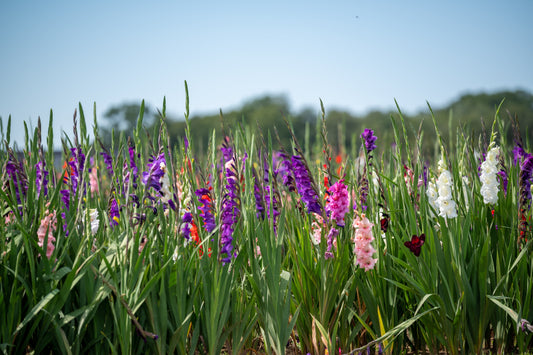Calla Lily Planting & Growing Guide
Planting Guide Information
-
4"Planting Depth
-
8-12" ApartPlanting Proximity
-
Spring to SummerPlanting Season
-
Long vase life and tropical interest in gardens.Plant Benefits
-
Moderate with growthWater Quantity
-
Late Spring through SummerBloom Season
-
Full Sun to Partial ShadeSunlight Quantity
-
Zones 8-10Hardiness Zones
Additional Growing Information
Where to Plant
Calla Lilies prefer locations with rich, well-drained soil and filtered light or moderate shade. They will burn in full sun, so be mindful when choosing a spot. If you notice water puddles 5–6 hours after a hard rain, you'll want to find another site or amend the soil with the addition of organic material to improve drainage. Calla Lilies aren't particularly fussy and will flourish near ponds and streams, but they will begin to rot in excessively soggy soil. If using containers, make sure there are adequate drainage holes and keep in mind the number of tubers you intend to plant when selecting a size.
When to Plant
Most Calla Lily varieties are winter hardy in zones 8–10 and should be planted outdoors in the spring after the risk of frost has passed. They can also be started in autumn in indoor containers or in warmer climates a month before the average last frost date to get a jump start. Roots and top sprouts will begin forming in the fall in warmer regions, with flowers arriving in the spring and summer.
How to Plant
- For container planting, select a container with adequate drainage holes and fill it with good quality, well-draining soil. Almost any commercially available potting mix will do the trick.
- For outdoor landscape planting, select a spot with well-drained soil where your Calla Lilies will receive filtered light or moderate shade.
- Dig holes and plant the tubers shallowly (no more than 4” deep) with the eyes facing upwards and the tops barely covered with soil or even slightly exposed.
- Water thoroughly after planting, gently soaking the soil to settle it around the tubers.
How to Grow
- Water as needed during active growth, aiming for about 1" of moisture per week.
- Leave the foliage in place after blooming has finished for the season. The leaves will gather sunlight to create food through photosynthesis, strengthening the tubers for the future.
- Allow your Callas to rest for a few months after flowering has finished before beginning the next growing cycle.
- Apply a layer of mulch, straw, or leaves around the tubers in the fall to protect them from the elements in warmer climates.
- Dig up the tubers and store them in slightly moist peat moss if you’re in a region cooler than zone 10 and would like to save them for next season.
Calla Lily Tips & Tricks
- Snip a few flowers for bouquets or other cut arrangements while in bloom. Doing so will not hurt your plants and having graceful, long-lasting blooms to bring indoors is one of the best reasons to grow Callas.
- Expect roots and top sprouts to form in the fall in warmer regions, with flowers emerging in the spring and summer.
- Amend poorly draining soil with organic material to raise the level 2–3" and improve drainage as Callas will not thrive in waterlogged soil. Compost, finely ground bark, or composted manure all work a charm and are widely available.
- Examine your tubers and discern where the growing points, or "eyes," are located. They should be planted with the eyes facing upwards.
From the Family
-
 40% Off
40% OffCalla - Aethiopica White Giant
3 Calla rhizomesRegular price $17.97Sale price $17.97 Regular priceUnit price per$29.9540% Off -
 15% OffPreorder
15% OffPreorderCalla - Amethyst
3 Calla rhizomesRegular price $16.96Sale price $16.96 Regular priceUnit price per$19.9515% OffPreorder -
 15% OffPreorder
15% OffPreorderCalla - Rainbow Mix
12 Calla rhizomes, mixed colorsRegular price $63.71Sale price $63.71 Regular priceUnit price per$74.9515% OffPreorder -
 15% OffPreorder
15% OffPreorderCalla - Pink Melody
3 Calla rhizomesRegular price $16.96Sale price $16.96 Regular priceUnit price per$19.9515% OffPreorder -
 15% OffPreorder
15% OffPreorderCalla - Pillow Talk
3 Calla rhizomesRegular price $16.96Sale price $16.96 Regular priceUnit price per$19.9515% OffPreorder








